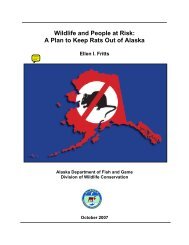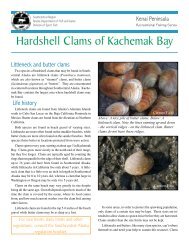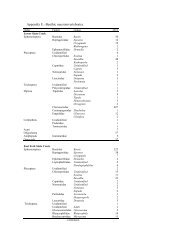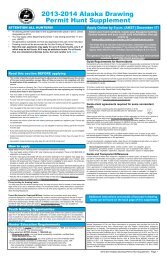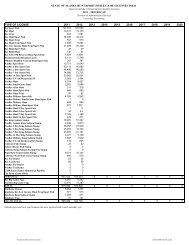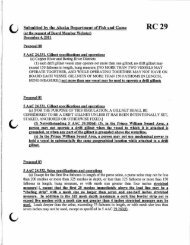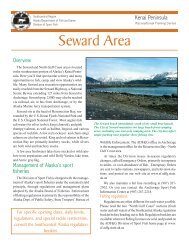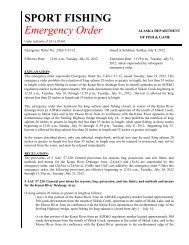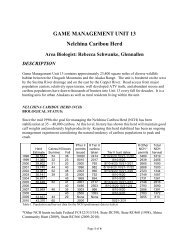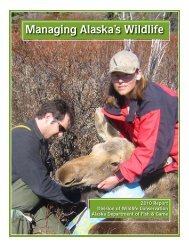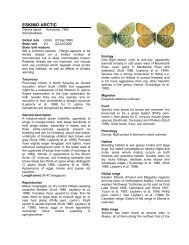fishery management report no. 12–46 - Alaska Department of Fish ...
fishery management report no. 12–46 - Alaska Department of Fish ...
fishery management report no. 12–46 - Alaska Department of Fish ...
You also want an ePaper? Increase the reach of your titles
YUMPU automatically turns print PDFs into web optimized ePapers that Google loves.
Chum salmon are primarily available in July and August during and just after the king salmon<br />
fisheries, and are targeted or caught incidentally while fishing for king salmon. While chum<br />
salmon are generally more abundant than king salmon, and are subject to a more liberal bag and<br />
possession limit (3 fish/day), average harvest and catch is lower than that for king salmon (Table<br />
4). The poor quality <strong>of</strong> chum salmon flesh for human consumption by the time the fish reach the<br />
Chena River is likely a contributing factor. Coho salmon are <strong>no</strong>t present in the Chena River<br />
drainage.<br />
Chena River king and chum salmon escapements have been annually assessed since 1986 using<br />
either mark-recapture experiments or a counting tower located at the Moose Creek dam (Table 3;<br />
Barton 1987, 1988; Barton and Conrad 1989; Brase 2012; Brase and Doxey 2006; Doxey 2004;<br />
Doxey et al. 2005; Evenson 1991a, 1992–1993, 1995, 1996; Evenson and Stuby 1997; Savereide<br />
2012a-b; Skaugstad 1990b, 1994; Stuby and Evenson 1998; Stuby 1999–2001). Counting<br />
conditions at the dam can be highly variable depending on water height and river turbidity. In<br />
2005 and 2011, the Chena River was extremely high and turbid for most <strong>of</strong> the king salmon run;<br />
therefore, escapement was <strong>no</strong>t estimated. In contrast, 2006 through 2010 had good counting<br />
conditions throughout the majority <strong>of</strong> the run and estimates <strong>of</strong> escapement were produced.<br />
Historically, the Chena River king salmon sport <strong>fishery</strong> was managed under a <strong>management</strong> plan<br />
with an escapement goal and a guideline harvest allocation for the sport <strong>fishery</strong>. A guideline<br />
sport harvest objective <strong>of</strong> 300–600 king salmon in the Chena River was set by the board in 1990.<br />
An aerial survey escapement index <strong>of</strong> 1,700 fish was set by Division <strong>of</strong> Commercial <strong>Fish</strong>eries in<br />
1992. In 1993, Division <strong>of</strong> Sport <strong>Fish</strong> staff expanded this aerial survey escapement index into an<br />
actual escapement abundance goal <strong>of</strong> 6,300 fish, as measured by the counting tower. This point<br />
objective was calculated based on averages <strong>of</strong> escapement data available at the time. Inseason<br />
<strong>management</strong> for the guideline harvest objectives was impractical because there was <strong>no</strong><br />
mechanism for day-to-day enumeration <strong>of</strong> the harvest and the harvest objectives were repealed in<br />
2001.<br />
In 2000, the department formed an escapement goal (EG) committee to evaluate and calculate<br />
EGs for Chena and Salcha rivers king salmon and for some Yukon River drainage chum salmon<br />
stocks. The EG process was designed to set escapement ranges which maximize potential yield.<br />
The EG committee recommended a biological escapement goal (BEG) range <strong>of</strong> 2,800–5,700<br />
king salmon, measured by the counting tower, for the Chena River based on an analysis <strong>of</strong> run<br />
reconstruction data related to brood year returns. There is <strong>no</strong> escapement goal set for chum<br />
salmon in the Chena River.<br />
Annual escapements <strong>of</strong> king salmon into the Chena and Salcha rivers mirror each other<br />
sufficiently so that inferences regarding attainment <strong>of</strong> BEGs for both rivers can be made even if<br />
good data are available from only 1 <strong>of</strong> the rivers (Table 3). If high water disrupts the counts in 1<br />
<strong>of</strong> the rivers, but <strong>no</strong>t the other, the escapement projections and estimates for the river in which an<br />
accurate estimate can still be made are considered an index <strong>of</strong> the king escapement in the other<br />
river, and are to be used as a measure <strong>of</strong> run strength rather than the BEG.<br />
A king salmon sport <strong>fishery</strong> has occurred at the Chena River since before statehood, and the bag<br />
and possession limit for king salmon in the Tanana River drainage has remained unchanged since<br />
the early 1960s, at one fish ≥ 20 inches (~510 mm). The <strong>fishery</strong> is easily accessible in the lower<br />
portion <strong>of</strong> the Chena River, with multiple boat launch and walk-in sites located throughout<br />
Fairbanks and North Pole. The <strong>fishery</strong> is closed above the Moose Creek Dam.<br />
9




